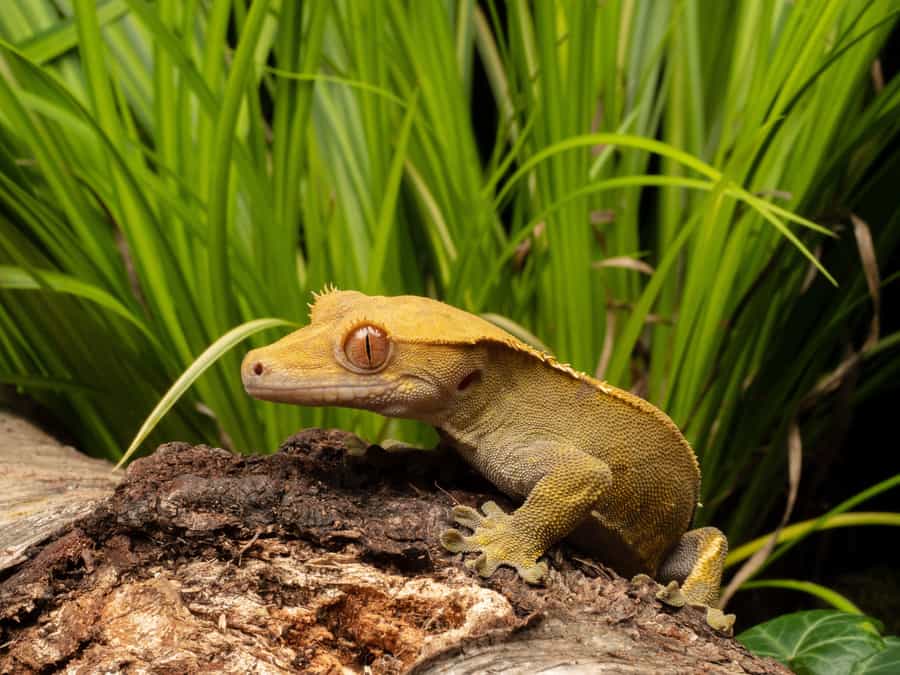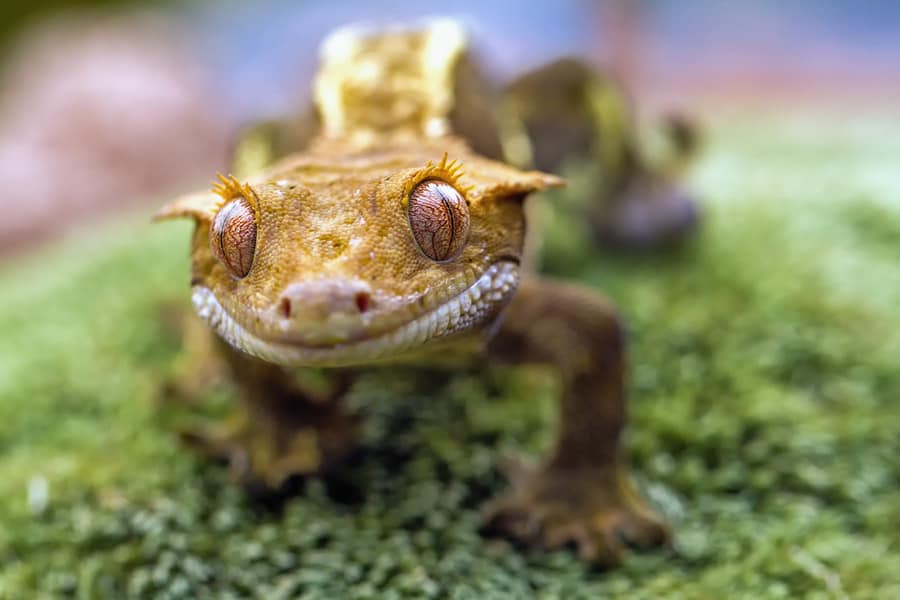It’s normal for a crested gecko to drop or lose its tail. For the unknowing pet owner, it can be quite a scary experience when you find your gecko without its tail, but it shouldn’t be cause for alarm.
Crested geckos are able to shed their tails in response to threat or danger but unlike many other related species, they cannot regrow their lost tails. Losing a tail should not impact the health of the gecko long-term.
But why do crested geckos drop their tails, and is there a way to prevent it? This guide will answer all your questions about how crested geckos shed their tales and why. You can also learn how to ensure your pet stays in good health regardless of whether or not it has its tail.

Do Crested Geckos Shed Their Tails and Why?
Crested Geckos, also called “eyelash geckos,” are known to drop their tails like green iguanas and other lizard reptiles. According to Lisa Abbo, Massachusetts-based DVM, a lizard can lose its tail whenever it’s under the threat of danger. It serves as an effective flight response for escaping scary situations.
For instance, assuming a predator traps a crestie, it can detach its tail to break loose and get away. This defense mechanism is “caudal autonomy,” meant to disarm any predator. In the wild, some geckos may spot a predator from afar and drop their tails before they even run away.
Immediately, the detached tail starts to wiggle, and this intense movement is what catches the predator off guard. It drives the attention away from the crested gecko because the hunter is more interested in the easy meal of the wiggling tail.
Do Crested Geckos Regrow Their Tails and Why?
As strange as it might seem, reptiles often regrow their tails after it has been detached. It is one of the most unique features among lizards, snakes, and bearded dragons. However, this regenerative ability doesn’t apply to crested geckos, so your crested gecko won’t grow a new tail.
Unlike other species of geckos, a crested gecko doesn’t regrow its tail and still functions just fine. Most gecko species possess multiple fracture frames between the tail bones, making it easier to detach the tail. This plane set allows them to regenerate their tail easily without requiring too much energy.
Meanwhile, a crested gecko has a fracture plane at the base of its tail. As a result, it may lose its tail but doesn’t grow a new one in its place.
Many lizards stop growing and reproducing, transferring all the energy to make a new tail. However, for crested geckos, this isn’t worth it, and they have learned how to adapt and exist properly without a tail.
To learn if crested geckos can be overfed, please check out this guide I wrote. For a complete breakdown of why blue-tongued skinks shed their tails, check out this guide. For a complete breakdown of why chameleons shed their tails, check out this guide.
Do Other Geckos Regrow their Tails?
Tail regeneration is common for many gecko species, such as the leachianus, gargoyle geckos, and leopard geckos. Most geckos regrow their nails within 30 days, which is faster than the average lizard. Once the tail is detached, the open end begins to repair itself, which builds new tissue and a new spinal cord at the site.
According to scientists, a typical gecko’s spinal cord hosts a unique type of stem cell called the ‘radial glia.’ Though these stem cells are generally dormant, they become temporarily active when there’s a tail loss. It aids cell proliferation and makes essential proteins that help develop a new spinal cord.
In addition, there’s no finite number of times where a gecko can regrow its tail, and researchers believe that most lizards regrow their tails multiple times in a 10-year existence.
However, some geckos may stop growing tails as they grow much older. The new tail may also look different from the rest of the tail and the gecko’s body.
If you are concerned about holding a crested gecko, this article I wrote on how crested geckos handle being held will put your mind at ease.
Are There Any Negative Effects of Not Having a Tail?
Simply put, a dropped tail is a natural reaction for a gecko in danger or during stressful situations. If you notice your gecko has dropped its tail, there’s no need for alarm or panic. It is common in younger lizards, and some geckos can regrow their tails. In the wild, many geckos take about 30 days to regrow their tails.
However, a crested gecko that has dropped its tail is known as a “frogbutt.” Since the animal cannot grow another tail to replace the old one, the rear end closes into a short stub resembling a frog’s bottom.
It is also quite common for adult cresties to naturally shed their tails, and it doesn’t cause any complications.
In addition, many crested geckos have naturally evolved to shed their tails as they grow older. It doesn’t in any way affect the growth and health status of the gecko.
Therefore, if your crested gecko loses its tail, you can be sure it’s not in immediate danger. You can also discuss with the vet how to help your pet cope with losing its tail if you like.
For a complete list of bad things for crested geckos, check out this helpful guide.
Does Shedding a Tail Hurt or Harm the Gecko?
Tail shedding is very common for geckos and many lizards, and generally, the only harm that a gecko gets from shedding its tail is a change in appearance.
Granted, seeing your animal without its tail at first may be strange, but after a few days, you and your crestie will adjust to the change.
Therefore, tail loss is merely a cosmetic issue and has no cause for medical concern. Still, when an enclosed pet crested gecko loses its tail, it may be a sign of a bigger issue.
For instance, where there’s an apparent danger, it’s normal for the animal to lose its tail. However, you may need to visit your vet if your gecko loses its tail and there’s a noticeable behavior change.
The tail loss may result from an illness or improper nutrition, so you can consult with the vet on what to do. Although a tail loss is not harmful, sudden shedding can signify something is wrong with your pet. It could also mean your pet is not getting proper nutrition and sleep.
Additionally, suppose the gecko’s enclosure is covered with sand or grating particles. In that case, you can move the animal to a clean and smooth surface.
It can ensure the open wound doesn’t get infected and stop healing. However, you don’t have to rub any creams or salve on the wound site, as this can irritate your gecko.
Do Crested Geckos Eat Their Tails?
Perhaps you’ve heard the rumors about a gecko eating its tail for survival. However, this is not true, and no crested geckos do not eat their tails. As we’ve discussed, the main reason a gecko drops its tail is when it’s frightened or feels threatened. With this in mind, it’s highly unlikely that a runaway crestie would return to eat its tail.
In addition, crested geckos have a specific diet of fruits, insects, and water. Even in the wild, crested geckos feed on peaches, bananas, apricots, and fruit nectar.
They also respond to a clean environment, so you can be sure your pet gecko isn’t interested in eating its tail. Keep in mind that there is no reported case where a crested gecko ate its tail after shedding.

All Causes of Tail Loss in Crested Geckos
There are common occasions where a crested gecko sheds its tail even without being in any danger. It is abnormal for a gecko to just shed its tail without any threat of harm from a predator. Here are some of the common conditions that may influence your gecko to shed its tail;
- Stress: All animals experience stress but have different coping mechanisms. Some shed excess hair or become more withdrawn. However, many crested geckos suffer from tail loss when stressed or anxious. A change in environment or climate may induce it. You must know and remove these stress factors to ensure your gecko remains healthy.
- Harsh temperature and humidity levels: Generally, crested geckos thrive in higher temperatures and humidity. Still, they can also get heat stress and dehydration when the climate becomes too extreme. If you notice lethargy and pacing, you can adjust the temperature levels before your gecko pounces on its tail.
- Poor diet: Crested geckos respond well to good nutrition and healthy sleeping patterns. If your gecko is not getting enough nourishment and sustenance, this can increase stress levels and cause tail loss. It is also important for cresties to get enough sleep during the day since they’re primarily nocturnal.
- Injury: Some crested geckos fall during a jump or while being picked up, which may cause severe injuries. It is not uncommon to see a crestie drop its tail as a shock response to the injury. In addition, some gecko parents have experienced seeing a wiggling tail in their palm after picking up the crestie from a fall.
- Illness: Though rare, diseases can cause your crested gecko tail to drop. Illnesses can reduce your gecko’s physical energy and affect its usual climb. As a result, it can shed off its tail to remove the extra weight.
Furthermore, other situations can cause a crested gecko to lose its tail, such as a stuck shed, discomfort, etc. Some geckos have old sheds at the end of their tails, which can be very uncomfortable for the lizard. Although it’s rare, some crested geckos pounce on their tails; they get too uncomfortable.
Does A Lost Tail Impact the Health of Crested Geckos (Or Reduce Lifespan)
Tail loss is very common among crested geckos in the wild. When a crested gecko sheds its tail, this is called autonomy, and it’s generally a painless process. It can happen when the gecko is in captivity and trying to escape danger. Though it rarely happens, a domesticated gecko may also lose its tail under stressful situations.
To learn if green iguanas shed their tails, check out this helpful guide.
However, you can be sure that a tail loss will not reduce the lifespan of a crested gecko. Unlike other geckos, a crestie can’t regrow its tail after shedding, but this is no cause for alarm.
Over the ages, cresties have evolved to live full lives without their tails. After shedding, it will heal naturally without needing a vet.
Aside from losing certain climbing benefits or cosmetic effects, a tail loss doesn’t impact your gecko’s well-being.
Your gecko will enjoy a full life with friendly temperature levels and proper living conditions. The common cause of a short lifespan of a gecko is illness or being hunted by a predator.
What Is the Function of a Tail in a Crested Gecko?
Geckos are among nature’s finest climbers; they can run across the ceiling and general vertical surfaces at full speed. Alongside its adhesive feet, the tail is the gecko’s most treasured climbing gear. A gecko’s foot is covered with tiny hairs that produce a strengthening effect that helps to keep the gecko up.
It has small flat feet and five toes with an adhesive pad that allows them to hang on surfaces without trouble. But the true climbing strength lies in a crested gecko’s tail.
The cresties’ tail is between 4 to 6 inches long, slender, and comes with impressive adhesive strength. It has a rounded tip with an adhesive plant at the end for surfaces like plants and branches.
In addition, the gecko can use its tail to manipulate and grab surrounding objects. You may notice your crested gecko using its tail to hang from a branch in its enclosure. In the wild, many crested geckos also use their tails for balance as they jump from one branch to another.
Final Thoughts
The bottom line is that tail loss is a natural phenomenon among crested geckos, raising no eyebrows. Many geckos in the wild live full lives and even willingly shed their tails as they grow older. However, crested geckos do not have the necessary features to grow their tails, unlike other lizards.
Ultimately, you don’t have to panic if your crested gecko sheds its tail. It can result from stress, improper nutrition, and other external conditions. Therefore, your crested gecko will thrive even after it sheds its tail. Meanwhile, it’s best to ensure the best living conditions for your pet to prevent stress-induced tail loss.
